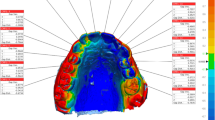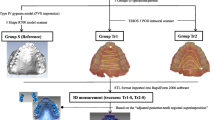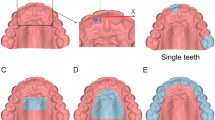Abstract
Palatal rugae are known in literature as individualizing anatomical structures with a strong potential for personal identification. However, a 3D assessment of their uniqueness has not yet been performed. The present study aims at verifying the uniqueness of 3D models of the palate. Twenty-six subjects were recruited among the orthodontic patients of a private dental office; from every patient, at least two dental casts were taken in different time periods, for a total of 62 casts. Dental casts were digitized by a 3D laser scanner (iSeries, Dental Wings©, Montreal, Canada). The palatal area was identified, and a series of 250 superimpositions was then performed automatically through VAM©software in order to reach the minimum point-to point distance between two models. In 36 matches the models belonged to the same individual, whereas in 214 mismatches they came from different subjects. The RMS (root mean square) of point-to-point distances was then calculated by 3D software. Possible statistically significant differences were assessed through Mann-Whitney test (p < 0.05). Results showed a statistically significant difference in RMS mean point-to-point distance between matches (mean 0.26 mm; SD 0.12) and mismatches (mean 1.30; SD 0.44) (p < 0.0001).All matches reached an RMS value below 0.50 mm. This study first provided an assessment of uniqueness of palatal rugae, based on their anatomical 3D conformations, with consequent applications to personal identification.



Similar content being viewed by others
References
Santos C, Caldas IM (2012) Palatal rugae pattern in a Portuguese population: a preliminary analysis. J Forensic Sci 57(3):786–788. https://doi.org/10.1111/j.1556-4029.2011.02016.x
Poojya R, Shruthi CS, Rajashekar VM, Kaimal A (2015) Palatal rugae patterns in edentulous cases, are they a reliable forensic marker? Int J Biomed Sci 11(3):109–112
Muthusubramanian M, Limson KS, Julian R (2005) Analysis of rugae in burn victims and cadavers to simulate rugae identification in cases of incineration and decomposition. J Forensic Odontostomatol 23(1):26–29
Dawasaz A, Dinkar AD (2013) Rugoscopy: predominant pattern, uniqueness, and stability assessment in the Indian Goan population. J Forensic Sci 58(6):1621–1627. https://doi.org/10.1111/1556-4029.12190
Adisa A, Kolude B, Ogunrinde TJ (2014) Palatal rugae as a tool for human identification. Niger J Clin Pract 17(5):641–643. https://doi.org/10.4103/1119-3077.141434
Bansode SC, Kulkarni MM (2009) Importance of palatal rugae in individual identification. J Forensic Dent Sci 1(2):77–81. https://doi.org/10.4103/0974-2948.60378
Mohammed RB, Patil RG, Pammi VR, Sandya MP, Kalyan SV, Anitha A (2013) Rugoscopy: human identification by computer-assisted photographic superimposition. J Forensic Dent Sci 5(2):90–95. https://doi.org/10.4103/0975-1475.119771
Hemanth M, Vidya M, Shetty N, Karkera BV (2010) Identification of individuals using palatal rugae: computerized method. J Forensic Dent Sci 2(2):86–90. https://doi.org/10.4103/0975-1475.81288
Limson KS, Julian R (2004) Computerized recording of the palatal rugae pattern and an evaluation of its application in forensic identification. J Forensic Odontostomatol 22(1):1–4
De Angelis D, Sala R, Cantatore A, Grandi M, Cattaneo C (2009) A new computer-assisted technique to aid personal identification. Int J Legal Med 123(4):351–356. https://doi.org/10.1007/s00414-008-0311-x
Gibelli D, Obertovà Z, Ritz-Timme S, Gabriel P, Arent T, Ratnayake M, De Angelis D, Cattaneo C (2016) The identification of living persons on images: a literature review. Legal Med 19:52–60. https://doi.org/10.1016/j.legalmed.2016.02.001
De Angelis D, Riboli F, Gibelli D, Cappella A, Cattaneo C (2012) Palatal rugae as an individualising marker: reliability for forensic odontology and personal identification. Sci Justice 52(3):181–184. https://doi.org/10.1016/j.scijus.2011.09.002
Naether S, Buck U, Campana L, Breitbeck R, Thali M (2012) The examination and identification of bite marks in foods using 3D scanning and 3D comparison methods. Int J Legal Med 126(1):89–95. https://doi.org/10.1007/s00414-011-0580-7
Molina A, Martin-de-las-Heras S (2015) Accuracy of 3D scanners in tooth mark analysis. J Forensic Sci 60(Suppl. 1):S222–S226. https://doi.org/10.1111/1556-4029.12598
De Angelis D, Gibelli D, Gaudio D, Cipriani Noce F, Guercini N, Varvara G, Sguazza E, Sforza C, Cattaneo C (2015) Sexualdimorphism of canine volume: a pilotstudy. Legal Med 17(3):163–166. https://doi.org/10.1016/j.legalmed.2014.12.006
Franco A, Willems G, Souza PH, Tanaka OM, Coucke W, Thevissen P (2017) Three-dimensional analysis of the uniqueness of the anterior dentition in orthodontically treated patients and twins. Forensic Sci Int 273:80–87. https://doi.org/10.1016/j.forsciint.2017.02.010
Taneva ED, Johnson A, Viana G, Evans CA (2015) 3D evaluation of palatal rugae for human identification using digital study models. J Forensic Dent Sci 7(3):244–252. https://doi.org/10.4103/0975-1475.172451
Batool A, Shaikh A, Fida M (2016) Stability of palatal rugae as a forensic marker in orthodontically treated cases. J Forensic Sci 61(5):1351–1355
Bailey LT, Esmailnejad A, Almedia MA (1996) Stability of the palatal rugae as landmarks for analysis of dental cases in extraction and non-extraction cases. Angle Orthod 66(1):73–78. https://doi.org/10.1043/0003-3219(1996)066<0073:SOTPRA>2.3.CO;2
Mustafa AC, Allouh MZ, Alshehab RM (2015) Morphological changes in palatal rugae patterns following orthodontic treatment. J Forensic Legal Med 31:19–22. https://doi.org/10.1016/j.jflm.2015.01.002
Shukla D, Clowdhry A, Bablani D, Jain P, Thapar R (2011) Establishing the reliability of palatal rugae pattern in individual identification (following orthodontic treatment). J Forensic Odontostomatol 29(1):20–29
Deepak V, Malgaonkar NI, Shah NK, Nasser AS, Dagrus K, Bassel T (2014) Palatal rugae patterns in orthodontically treated cases, are they a reliable forensic marker? J Int Oral Health 6(8):89–95
Acknowledgements
We thank Ms. Alice Loviglio for her precious help in data collection and analysis.
Author information
Authors and Affiliations
Corresponding author
Ethics declarations
Conflict of interest
The authors declare that they have no conflict of interest.
Rights and permissions
About this article
Cite this article
Gibelli, D., De Angelis, D., Pucciarelli, V. et al. Application of 3D models of palatal rugae to personal identification: hints at identification from 3D-3D superimposition techniques. Int J Legal Med 132, 1241–1245 (2018). https://doi.org/10.1007/s00414-017-1744-x
Received:
Accepted:
Published:
Issue Date:
DOI: https://doi.org/10.1007/s00414-017-1744-x




